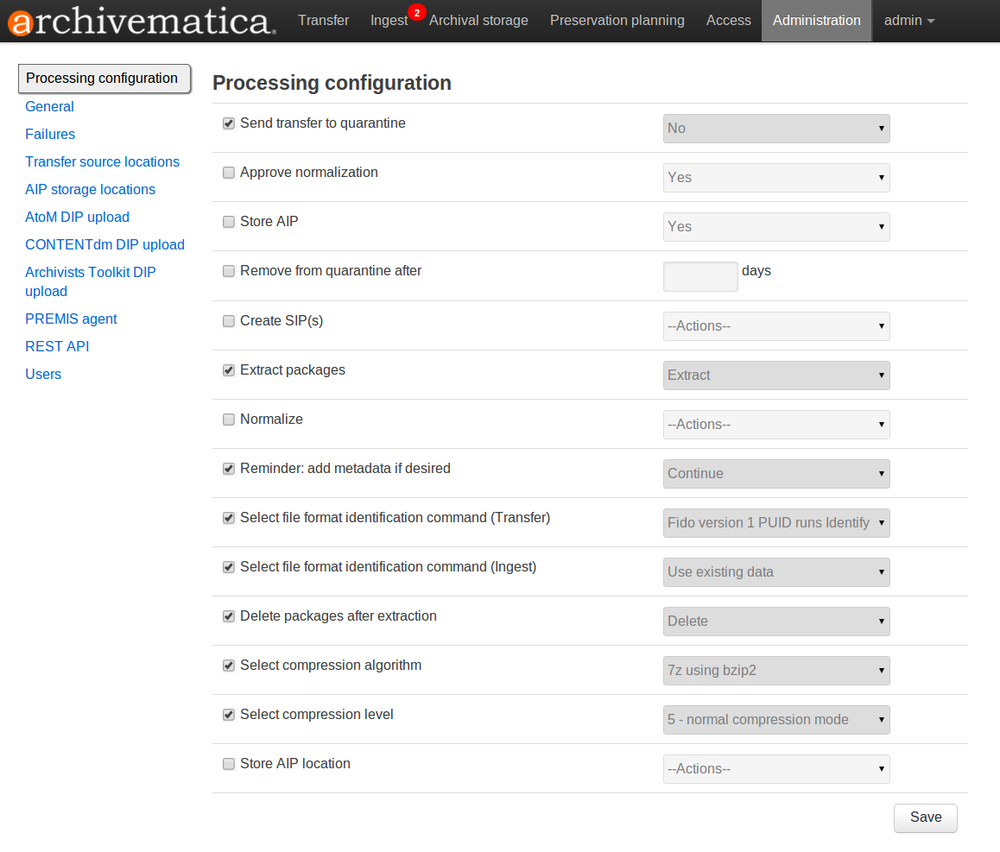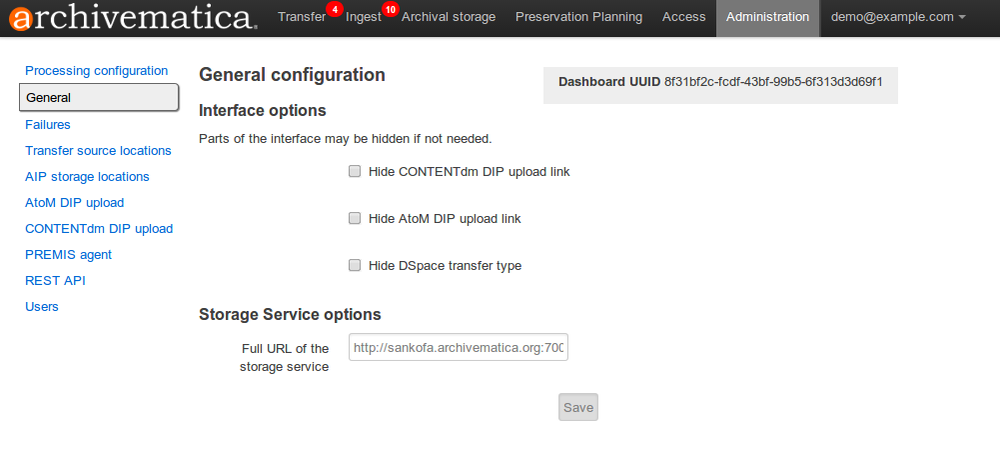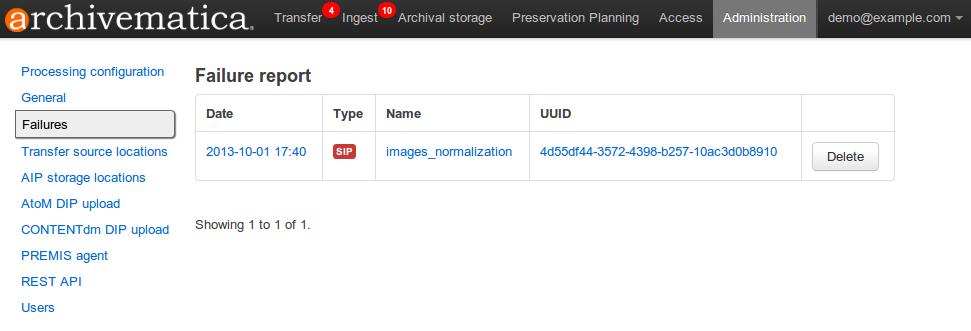Difference between revisions of "UM administration 1.1"
| Line 13: | Line 13: | ||
The processing configuration administration page of the dashboard provides you with an easy form to configure the default 'processingMCP.xml' that's added to a SIP or transfer if it doesn't already contain one. When you change the options using the web interface the necessary XML will be written behind the scenes. | The processing configuration administration page of the dashboard provides you with an easy form to configure the default 'processingMCP.xml' that's added to a SIP or transfer if it doesn't already contain one. When you change the options using the web interface the necessary XML will be written behind the scenes. | ||
</br> | </br> | ||
| − | [[File: | + | [[File:ProcessingConfig1-1.png|1000px|center|thumb|Processing configuration form in Administration tab of the dashboard]] |
</br> | </br> | ||
*For the approval (yes/no) steps, the user ticks the box on the left-hand side to make a choice. If the box is not ticked, the approval step will appear in the dashboard. | *For the approval (yes/no) steps, the user ticks the box on the left-hand side to make a choice. If the box is not ticked, the approval step will appear in the dashboard. | ||
Revision as of 12:16, 28 April 2014
Main Page > Documentation > User manual > User manual 1.1 > User administration
General description
This page describes dashboard user administration in Archivematica 1.1 via the dashboard. For higher level, technical administrative documentation, please see Administrator manual 1.1
Dashboard administration tab
The Archivematica administration pages, under the Administration tab of the dashboard, allows you to configure application components and manage users.
Processing configuration
The processing configuration administration page of the dashboard provides you with an easy form to configure the default 'processingMCP.xml' that's added to a SIP or transfer if it doesn't already contain one. When you change the options using the web interface the necessary XML will be written behind the scenes.
- For the approval (yes/no) steps, the user ticks the box on the left-hand side to make a choice. If the box is not ticked, the approval step will appear in the dashboard.
- For the other steps, if no actions are selected the choices appear in the dashboard
- You can select whether or not to send transfers to quarantine (yes/no) and decide how long you'd like them to stay there.
- You can approve normalization, sending the AIP to storage, and uploading the DIP without interrupting the workflow in the dashboard.
- You can pre-select which format identification tool to run in both transfer and ingest to base your normalization upon.
- You can choose to send a transfer to backlog or to create a SIP every time.
- You can select between 7z using lzma and 7zip using bzip or parallel bzip2 algorithms for AIP compression.
- For select compression level, the options are as follows:
- 1 - fastest mode
- 3 - fast compression mode
- 5 - normal compression mode
- 7 - maximum compression
- 9 - ultra compression
- You can select one archival storage location where you will consistently send your AIPs.
General
In the general configuration section, you can select interface options and set Storage Service options for your Archivematica client.
Interface options
Here, you can hide parts of the interface that you don't need to use. In particular, you can hide CONTENTdm DIP upload link, AtoM DIP upload link and DSpace transfer type.
Storage Service options
This is where you'll find the complete URL for the Storage Service. See Storage Service for more information about this feature.
Failures
Archivematica 1.1 includes dashboard failure reporting.
Transfer source location
Archivematica allows you to start transfers using the operating system's file browser or via a web interface. Source files for transfers, however, can't be uploaded using the web interface: they must exist on volumes accessible to the Archivematica MCP server and configured via the Storage Service.
When starting a transfer you're required to select one or more directories of files to add to the transfer.
You can view your transfer source directories in the Administrative tab of the dashboard under "Transfer source locations".
AIP storage locations
AIP storage directories are directories in which completed AIPs are stored. Storage directories can be specified in a manner similar to transfer source directories using the Storage Service.
You can view your transfer source directories in the Administrative tab of the dashboard under "AIP storage locations"
AtoM DIP upload
Archivematica can upload DIPs directly to an AtoM website so the contents can be accessed online. The AtoM DIP upload configuration page is where you specify the details of the AtoM installation you'd like the DIPs uploaded to (and, if using Rsync to transfer the DIP files, Rsync transfer details).
The parameters that you'll most likely want to set are url, email, and password. These parameters, respectively, specify the destination AtoM website's URL, the email address used to log in to the website, and the password used to log in to the website.
AtoM DIP upload can also use Rsync as a transfer mechanism. Rsync is an open source utility for efficiently transferring files. The rsync-target parameter is used to specify an Rsync-style target host/directory pairing, "foobar.com:~/dips/" for example. The rsync-command parameter is used to specify rsync connection options, "ssh -p 22222 -l user" for example. If you are using the rsync option, please see AtoM server configuration below.
To set any parameters for AtoM DIP upload change the values, preserving the existing format they're specified in, in the "Command arguments" field then click "Save".
Note that in AtoM, the sword plugin (Admin --> Plugins --> qtSwordPlugin) must be enabled in order for AtoM to receive uploaded DIPs. Enabling Job scheduling (Admin --> Settings --> Job scheduling) is also recommended.
CONTENTdm upload
Users can process digital content and then upload the DIP to CONTENTdm as the access system. Artefactual recommends that a technical administrator configure the options for this feature.
To configure Archivematica to upload a DIP to CONTENTdm, see Administrator manual - CONTENTdm upload. Please note the user must create the target collection in CONTENTdm before uploading the DIP.
PREMIS agent
The PREMIS agent name and code can be set via the administration interface.
REST API
Archivematica includes a REST API for automating transfer approval. Artefactual recommends that a technical administrator configure the options for this feature.
To configure Archivematica to use the REST API for automation, see Administrator manual - REST API
Users
The dashboard provides a simple cookie-based user authentication system using the Django authentication framework. Access to the dashboard is limited only to logged-in users and a login page will be shown when the user is not recognized. If the application can't find any user in the database, the user creation page will be shown instead, allowing the creation of an administrator account.
Users can be also created, modified and deleted from the Administration tab. Only users who are administrators can create and edit user accounts.
You can add a new user to the system by clicking the "Add new" button on the user administration page. By adding a user you provide a way to access Archivematica using a username/password combination. Should you need to change a user's username or password, you can do so by clicking the "Edit" button, corresponding to the user, on the administration page. Should you need to revoke a user's access, you can click the corresponding "Delete" button.



